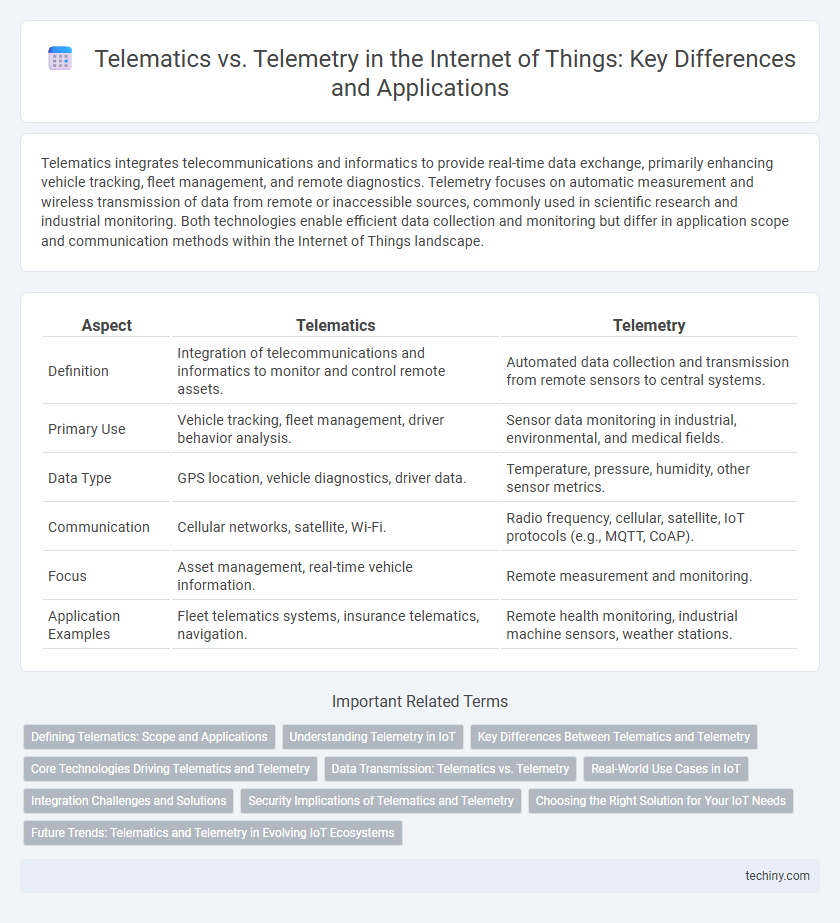Telematics integrates telecommunications and informatics to provide real-time data exchange, primarily enhancing vehicle tracking, fleet management, and remote diagnostics. Telemetry focuses on automatic measurement and wireless transmission of data from remote or inaccessible sources, commonly used in scientific research and industrial monitoring. Both technologies enable efficient data collection and monitoring but differ in application scope and communication methods within the Internet of Things landscape.
Table of Comparison
| Aspect | Telematics | Telemetry |
|---|---|---|
| Definition | Integration of telecommunications and informatics to monitor and control remote assets. | Automated data collection and transmission from remote sensors to central systems. |
| Primary Use | Vehicle tracking, fleet management, driver behavior analysis. | Sensor data monitoring in industrial, environmental, and medical fields. |
| Data Type | GPS location, vehicle diagnostics, driver data. | Temperature, pressure, humidity, other sensor metrics. |
| Communication | Cellular networks, satellite, Wi-Fi. | Radio frequency, cellular, satellite, IoT protocols (e.g., MQTT, CoAP). |
| Focus | Asset management, real-time vehicle information. | Remote measurement and monitoring. |
| Application Examples | Fleet telematics systems, insurance telematics, navigation. | Remote health monitoring, industrial machine sensors, weather stations. |
Defining Telematics: Scope and Applications
Telematics encompasses the integration of telecommunications and informatics to enable real-time data transmission and analysis across connected devices, primarily in automotive, fleet management, and insurance industries. It involves GPS tracking, vehicle diagnostics, and driver behavior monitoring, providing actionable insights to enhance safety, efficiency, and compliance. The scope of telematics extends to asset tracking, remote monitoring, and usage-based services, leveraging the Internet of Things (IoT) to optimize operations and reduce costs.
Understanding Telemetry in IoT
Telemetry in IoT refers to the automated process of collecting and transmitting sensor data from remote devices to a central system for monitoring and analysis, enabling real-time insights into device performance and environmental conditions. Unlike telematics, which integrates telecommunications with vehicular technologies for tracking and diagnostics, telemetry focuses broadly on sensor data acquisition across diverse IoT applications such as smart agriculture, industrial automation, and health monitoring. Efficient telemetry systems optimize bandwidth usage and ensure accurate data delivery, crucial for predictive maintenance and operational efficiency in connected IoT ecosystems.
Key Differences Between Telematics and Telemetry
Telematics integrates telecommunications and informatics to provide real-time data exchange, primarily used in vehicle tracking and fleet management, while telemetry focuses on the remote measurement and transmission of data from sensors to monitoring systems. Telematics systems typically include GPS, onboard diagnostics, and communication networks, enabling comprehensive analytics and control, whereas telemetry emphasizes single-point data collection with less emphasis on complex analysis. The key difference lies in telematics' broader capability for two-way communication and data processing compared to telemetry's simpler one-way data transmission.
Core Technologies Driving Telematics and Telemetry
Core technologies driving telematics include GPS for real-time location tracking, cellular networks for data transmission, and onboard diagnostics (OBD) systems for vehicle health monitoring. Telemetry relies on sensors and wireless communication protocols such as Zigbee, LoRa, and NB-IoT to collect and transmit data from remote devices to central systems. Both telematics and telemetry leverage cloud computing and edge computing to process and analyze large volumes of IoT data efficiently.
Data Transmission: Telematics vs. Telemetry
Telematics integrates telecommunications and informatics to enable two-way data transmission, allowing real-time monitoring, vehicle tracking, and remote diagnostics. Telemetry focuses on one-way data transmission from remote sensors to centralized systems for measurement and analysis, often used in industrial monitoring or environmental data collection. Both technologies optimize data flow, but telematics emphasizes interactive communication, whereas telemetry prioritizes reliable data reporting.
Real-World Use Cases in IoT
Telematics integrates telecommunications and informatics to provide real-time vehicle tracking, fleet management, and usage-based insurance in IoT ecosystems. Telemetry enables remote monitoring and data transmission from sensors in industrial automation, smart agriculture, and healthcare devices. Both technologies enhance IoT applications by delivering critical data for decision-making and operational efficiency in connected systems.
Integration Challenges and Solutions
Integration challenges in telematics and telemetry often stem from data standardization differences and the complexity of syncing heterogeneous sensor inputs. Implementing middleware solutions and adopting unified IoT communication protocols like MQTT or CoAP can streamline data aggregation and improve interoperability. Leveraging cloud-based platforms with scalable APIs enhances real-time monitoring and analytics capabilities across telematics and telemetry systems.
Security Implications of Telematics and Telemetry
Telematics and telemetry both involve data transmission from remote devices, but telematics integrates GPS and vehicle diagnostics, increasing exposure to cyber threats targeting location and personal data. Telemetry primarily focuses on automated data collection and monitoring, presenting risks related to unauthorized access and data interception in critical infrastructure systems. Strong encryption protocols and real-time anomaly detection are essential to mitigate security vulnerabilities inherent in both technologies within Internet of Things (IoT) ecosystems.
Choosing the Right Solution for Your IoT Needs
Telematics integrates telecommunications and informatics to provide real-time data and analytics for vehicle and asset management, making it ideal for IoT applications requiring GPS tracking and remote diagnostics. Telemetry, relying on automated data collection and transmission from sensors, suits IoT systems focused on monitoring environmental conditions or industrial processes. Selecting the right solution depends on the specific IoT requirements: telematics excels in mobile asset tracking, whereas telemetry offers precise sensor data for stationary and remote monitoring.
Future Trends: Telematics and Telemetry in Evolving IoT Ecosystems
Future trends in Telematics and Telemetry within evolving IoT ecosystems emphasize enhanced real-time data collection, seamless integration with AI analytics, and robust cybersecurity measures. The convergence of 5G connectivity with IoT devices accelerates data transmission speeds, promoting smarter transportation systems and predictive maintenance applications. Advanced sensor technologies and edge computing further empower Telematics and Telemetry to drive innovation in smart cities, autonomous vehicles, and industrial automation.
Telematics vs Telemetry Infographic

 techiny.com
techiny.com